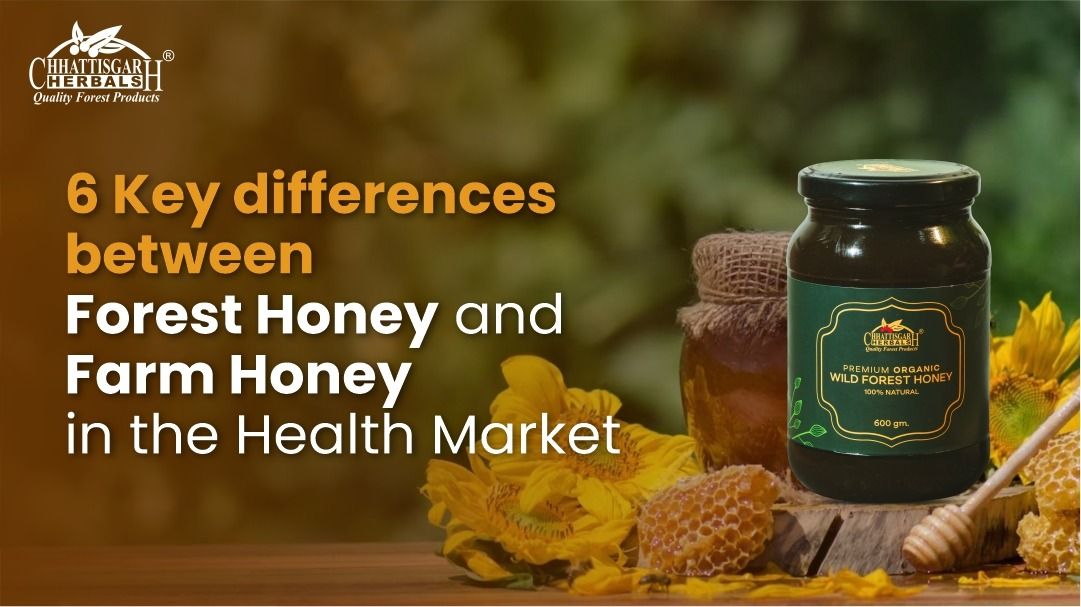6 Key differences between Forest Honey and Farm Honey in the Health Market
Discover the health market's buzzworthy debate: Forest Honey vs. Farm Honey. While farm honey boasts consistency, forest honey stands out with its diverse nutrients from wild flora, offering a unique blend for holistic wellness enthusiasts

Honey has several benefits: it is full of antioxidants and enzymes, honey helps make our immune system stronger, fights off infections, and keeps us healthy. Drinking honey with warm water can help our digestion and might even help us lose some belly fat. It's not just tasty, it's like a super remedy that can make us feel better in lots of different ways.
So, what type of honey do you use? Yes, honey has its types and benefits. Two major types of honey are Forest honey and Farm honey. The forest honey is raw directly obtained from the forest whereas farm honey is cultivated on farms.
Read further to get all your answers related to the forest honey, its taste and how it is different and natural compared to other types.
Wild forest honey vs Farm honey
Here are six key differences between raw forest honey and cultivated farm honey based on certain criteria :
Source of Origin:
- Forest honey is harvested from natural bee hives in forests, where bees collect nectar from wildflowers and diverse flora.
- Farm honey, on the other hand, comes from bee boxes managed by beekeepers, often near specific flowers or plants, and the bees are usually fed a controlled diet.
Production Environment:
- Forest honey is sourced from wild bees in their natural habitat, leading to a more diverse range of flora and potentially more varied flavours.
- Farm honey is produced under controlled conditions, allowing beekeepers to manage the bees' diet and habitat, which might result in more consistent but potentially less diverse flavours.
Texture and Composition:
- Forest honey tends to be thicker and might contain particles like bee pollen, propolis, honeycomb bits, and even bee wing fragments, giving it a cloudy appearance.
- Farm honey often has a smoother texture and is more likely to be clear without visible particles due to controlled harvesting and processing.
Crystallization and Consistency:
- Raw forest honey, due to its natural state, may have a finer texture and tends to crystallize with time, becoming thicker.
- Farm honey might crystallize as well but could have added processes to prevent or slow down crystallization, maintaining a smoother consistency for longer periods.
Flavour Profile:
- Forest honey typically carries a warm butterscotch taste with hints of bitterness and diverse floral notes, attributed to the varied flora available to wild bees.
- Farm honey flavours may be more consistent and controlled, often influenced by the specific types of flowers or plants near the hives.
Nutritional Composition:
- Forest honey, especially raw wild honey, might contain higher levels of antioxidants, owing to its natural state and the diverse sources of nectar.
- Farm honey could also have nutritional benefits but might vary based on the managed diet of the bees and the specific flora available around the farm.
These differences highlight the various aspects including sourcing, environment, composition, texture, flavour, and nutritional value that distinguish forest honey from farm honey.
Wild forest honey benefits
Here are some of the benefits for the forest honey over the farm honey:
Cholesterol Management: Forest honey, particularly wild variants, aids in reducing bad cholesterol (LDL) and increasing good cholesterol (HDL), potentially lowering the risk of heart diseases. This benefit might not be as pronounced in farm honey.
- Enhanced Immune Support: Phytonutrients present in forest honey possess antioxidant, antibacterial, and antifungal properties, bolstering the immune system. This aspect might be more potent in forest honey compared to farm honey.
- Respiratory Health Improvement: Forest honey demonstrates proven benefits in alleviating respiratory disease symptoms and reducing lung airway inflammation. Such respiratory benefits might not be as prominent in farm honey.
- Natural Antiseptic and Infection Fighter: Forest honey's natural hydrogen peroxide, combined with its antibacterial and antifungal properties, serves as an effective remedy against infections. This natural antiseptic quality might be less present in farm honey.
- Low Glycaemic Index and Weight Management: Forest honey has a lower glycaemic index than regular sugars, making it a suitable sugar replacement, aiding weight management. This characteristic might not be as prevalent in farm honey.
- Skin Health and Remedial Benefits: Forest honey serves as a natural remedy for dandruff, eczema, skin infections, and blemishes due to its antibacterial and antifungal effects. These skin benefits might not be as pronounced in farm honey.
- General Health Benefits: Wild honey has various general health benefits like aiding in diabetes management, providing energy, combating dehydration, acting as a mood enhancer, and supporting digestion. These wide-ranging benefits might differ in intensity or presence in farm honey.
What does forest honey taste like Chhattisgarh Herbals Forest honey tastes a bit like warm butterscotch with a touch of bitterness. It's not as sweet as some other honey and has a hint of floral flavour that's really nice. What's interesting is that it also has a slightly salty taste, making it different and unique.